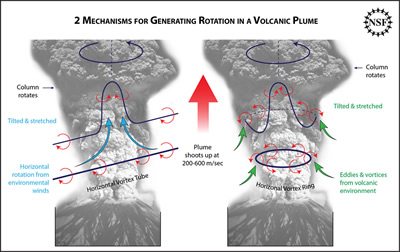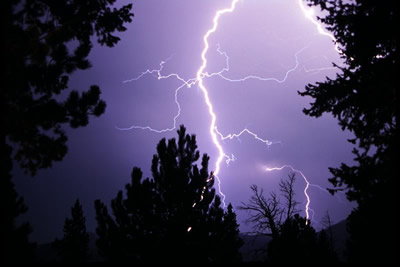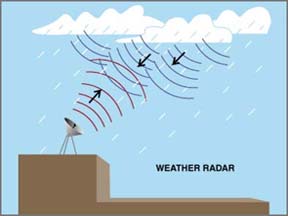Click on image for full size
Image Courtesy of the Zina Deretsky/NSF, after Chakraborty et al., Volcanic mesocyclones, Nature, 3/26/09
Tornado-like Rotation is Key to Understanding Volcanic Plumes
News story originally written on March 23, 2009
Scientists are using information they have from past volcanic eruptions to better understand strong volcanic plumes. They have observed that in some volcanic eruptions, there is a spontaneous formation of a "volcanic mesocyclone," which is a rotating, column-shaped vortex that causes the volcanic plume to rotate on its axis. This rotation triggers the formation of lightning and creates waterspouts or dust devils. Waterspouts are like dust devils on land, but they contain water when they are over the ocean.
This phenomena was photographed during the 2008 eruption of Mount Chaiten in southern Chile. In addition, scientists have found a paper written by a sea captain in 1811. In the paper, the captain reported that he saw a volcanic vent coming out of the sea in the Azores archipelago that contained a large volcanic plume. According to the captain, the plume rotated on the water like a wheel and there were continuous flashes of lightning and a lot of waterspouts.
The scientists that worked on this project think that the rotation of these volcanic plumes is the primary cause of tornadoes, waterspouts, and lightning that have been seen in the plumes. They also think this process is similar to how a strong thunderstorm creates a tornado. The plume contains a column of hot gases and dust topped with an "umbrella."
In the future, scientists plan to look at satellite images of volcanic plumes taken every few minutes so they can study the formation of these umbrellas, with the rotation and lightning that go along with them. They also plan to study the volcanic plumes using Doppler radar, which is something meteorologists use to study thunderstorms but hasn't been used to study volcanoes before.















